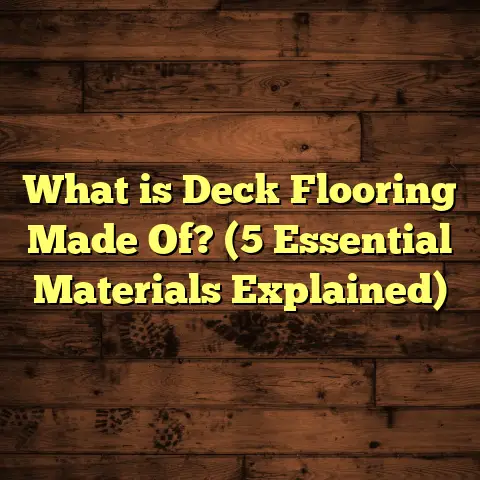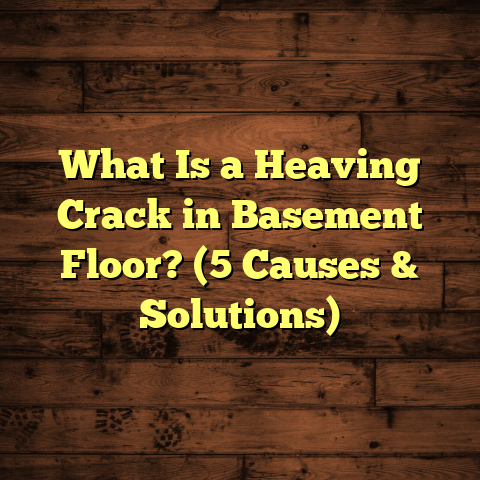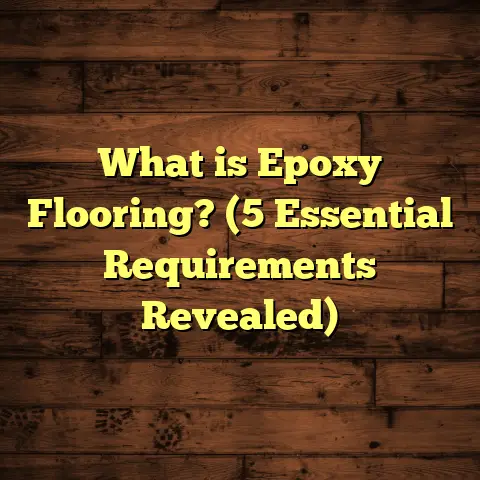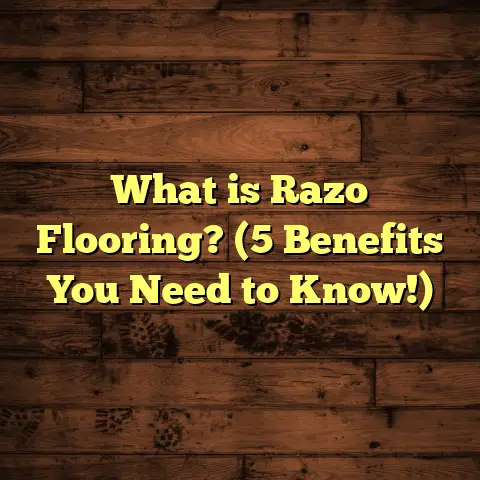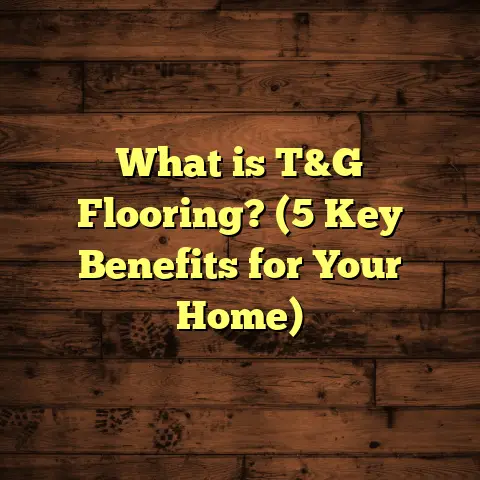What is Plank Flooring? (5 Key Benefits You Need to Know)
Have you ever walked into a room and felt instantly drawn to the floor? That smooth, continuous stretch of wood or wood-like material beneath your feet that seems to pull the whole space together? I’ve been in the flooring business for years, and one thing I can tell you is that plank flooring has a way of doing just that. It’s not just a surface you walk on — it’s a design element, a functional feature, and sometimes even a conversation starter.
If you’re thinking about updating or installing new floors, you’ve probably heard the term “plank flooring” tossed around a lot. But what exactly does it mean? How does it differ from other flooring options? And why might it be the right (or wrong) choice for your home or office?
Let me take you on a detailed walk through everything you should know about plank flooring — from what it is, to its benefits, to my personal insights from years of hands-on experience. Along the way, I’ll share stories, data, tips, and even some tools that have helped me make smarter decisions on every project.
What Is Plank Flooring?
When I first started working with floors, I quickly realized that terminology can get confusing. People often mix up plank flooring with strip flooring or hardwood flooring in general. So here’s the straightforward explanation:
Plank flooring consists of individual boards that are longer and wider than traditional strip floors. While strip flooring usually involves narrow boards (around 2-3 inches wide), plank floors are typically 4 inches or wider — sometimes even up to 7 or 8 inches. The length of each plank can vary but often ranges from 24 inches to over 7 feet.
These planks can be made from various materials:
- Solid hardwood: A single piece of wood cut from a tree.
- Engineered wood: Multiple layers of wood veneer pressed together with a hardwood top layer.
- Laminate: A fiberboard core topped with a photographic layer simulating wood grain and a protective coating.
- Vinyl: A synthetic plank mimicking wood look but waterproof and often more durable against moisture.
Here’s why this matters: The size and material of the planks influence not only the look but also the installation method, durability, cost, and maintenance.
A Little History
Back when I started in this trade, plank flooring was primarily solid hardwood installed in older homes or upscale renovations. The look was classic — long oak or pine planks with natural grain patterns creating warmth and charm.
Over time, manufacturers introduced engineered wood and laminate planks, making the plank flooring style accessible to more people at different budgets and needs.
Today, vinyl plank flooring has become hugely popular due to its waterproof nature and ease of installation. It’s common in kitchens, bathrooms, and even commercial spaces where moisture is a concern.
Why Plank Size Matters
Have you noticed how wider planks tend to look more modern or rustic depending on the finish? Wider planks show off the wood grain better but require careful installation to avoid cupping or gaps.
Narrower planks may feel more traditional but create more seams, which can be harder to keep clean and maintain visually.
From my experience, selecting the right plank width is as integral to design as picking the color or finish. It sets the tone for the room’s entire style.
1. Stunning Aesthetic Appeal That Adds Value
I can’t stress enough how much plank flooring impacts a room’s appearance. When I’m consulting with clients about flooring options, their eyes often light up when they see wide plank samples laid out side by side.
The Visual Impact
Wide planks create fewer seams across the floor area, which gives rooms a smooth, flowing look that feels open and uncluttered. This visual continuity can make small rooms appear larger and large rooms feel elegantly unified.
One client of mine had a cramped dining room with old tile floors. After installing 7-inch wide hickory planks stained in a warm walnut tone, she told me it was like walking into a whole new house. The floor’s seamless effect transformed the space from outdated to contemporary cozy.
Statistical Insight: According to a survey by Houzz, 49% of homeowners said that upgrading to hardwood plank flooring was one of their top home renovation projects for increasing home value.
Customization Options
Another great aspect is how versatile plank flooring is in terms of finish and texture:
- You can pick from smooth finishes for sleek modern looks.
- Or go with distressed and hand-scraped textures for rustic charm.
- Matte finishes reduce glare for cozy spaces.
- High gloss adds sparkle for formal rooms.
This variety lets you customize the floor to match your personality and décor perfectly.
Color Trends & Design Flexibility
Over the years, I’ve seen color trends shift dramatically—from classic natural woods to grays, whites, and even blacks. Wide plank floors work well with all these trends because their large surface showcases color beautifully.
For instance, light gray oak planks can brighten dark interiors and pair well with minimalist furniture. Dark walnut planks add warmth to airy open plans with natural lighting.
If you’re unsure about color choices, try ordering samples and lay them down in your space at different times of day. Lighting affects how plank colors appear.
2. Durability and Longevity You Can Count On
When people invest in new floors, one question I always hear is: “How long will this last?” And rightly so — floors are a big investment.
Why Plank Flooring Lasts
Solid hardwood planks are incredibly durable because they’re made of solid natural wood. They can be sanded down multiple times over decades to remove scratches or wear marks — literally renewing your floor instead of replacing it.
Engineered wood planks share some of this durability but with added resistance to moisture due to their layered construction. This makes them ideal for basements or places where humidity fluctuates.
Vinyl planks aren’t wood but offer extraordinary resistance to dents, scratches, stains, and water damage. They’re perfect in high-traffic homes with pets or kids.
Interesting Data: The Hardwood Flooring Manufacturers Association notes that hardwood floors can last over 75 years if properly maintained.
Real-Life Example
I once worked on restoring an old farmhouse that had original 100-year-old oak plank floors hidden under layers of carpet for decades. After sanding and refinishing, those floors looked brand new — stronger than many modern alternatives.
This timeless durability is why many homeowners choose plank floors over carpet or tile, which may need replacement after 10-15 years.
How Maintenance Affects Longevity
The key to long-lasting plank floors isn’t just the material but how you care for it:
- Avoid dragging heavy furniture directly on floors.
- Use rugs in entryways to trap dirt.
- Clean spills quickly to prevent damage.
- Refinish hardwood every 7-10 years depending on wear.
3. Easier Installation With Modern Innovations
You might think installing wide plank floors is complicated or only for pros — but that’s not always true. Technology has made installation easier than ever.
Click-Lock Systems & DIY-Friendly Kits
Most contemporary plank flooring options come with click-lock edges that snap together like puzzle pieces without glue or nails. This floating floor method reduces installation time drastically and minimizes mess.
When I started using click-lock engineered wood planks several years ago on smaller projects, I noticed how much faster my teams worked compared to traditional nail-down methods.
For homeowners comfortable with tools, installing vinyl or laminate plank floors themselves is very doable—saving money on labor without sacrificing quality.
Important Installation Tips
- Acclimate your planks by leaving them in the installation room for 48-72 hours before starting.
- Ensure subfloor is clean, dry, and level.
- Leave expansion gaps around edges as per manufacturer instructions.
One mistake I’ve seen beginners make is rushing cuts without proper measuring—always double-check measurements before cutting!
How FloorTally Helps Me Plan Installation
I use an online tool called FloorTally during project planning. By inputting room dimensions and flooring type, it calculates how many planks I need including waste factor — critical since cutting planks creates scrap material.
It also estimates total cost including labor rates in my area based on real-time data. This helps me set realistic expectations with clients before buying materials or booking installers.
This planning step has saved me time and extra expenses many times over throughout my career.
4. Low Maintenance Requirements That Save You Time
If you’re like me, you don’t want floors that demand constant cleaning or special treatment every week.
Simple Cleaning Routines
Plank floors are relatively low maintenance compared to carpet or grout-lined tile floors:
- Sweep or vacuum regularly to remove dust.
- Damp mop occasionally using manufacturer-approved cleaners.
- Wipe spills immediately especially on hardwood to avoid stains or warping.
With vinyl plank floors especially, stains wipe off easily without scrubbing hard.
Avoiding Common Pitfalls
I often advise clients to avoid harsh chemicals like bleach or ammonia on wood floors as they damage finish coats over time. Also steer clear of excessive water during mopping since standing water can warp wood planks.
Adding felt pads under furniture legs prevents scratches when moving chairs or tables around—simple steps that prolong floor life massively.
5. Versatility Across Rooms and Styles
One thing I love about plank flooring is how adaptable it is across different spaces and décor styles. Whether you want rustic farmhouse charm or sleek modern minimalism, there’s a plank floor option for you.
Room-by-Room Suitability
- Living rooms & bedrooms: Hardwood or engineered wood planks create warmth and elegance.
- Kitchens: Waterproof vinyl planks handle spills without worry.
- Bathrooms & laundry rooms: Vinyl planks are often the best choice here due to moisture resistance.
- Basements: Engineered wood or vinyl planks tolerate fluctuating humidity better than solid wood.
Commercial Spaces & High Traffic Areas
I’ve installed luxury vinyl plank flooring in offices and retail stores because it holds up well under heavy foot traffic while maintaining an attractive appearance.
Cost Considerations: What You Should Know
Cost is always a big question when deciding on new floors. Plank flooring prices vary widely depending on material quality, brand, finish type, width/thickness of planks, and labor rates where you live.
Cost Ranges I’ve Seen:
| Material | Price per Sq Ft (Material Only) | Installation Cost per Sq Ft |
|---|---|---|
| Solid Hardwood | $5 – $15 | $3 – $10 |
| Engineered Wood | $3 – $10 | $2 – $8 |
| Laminate | $1 – $4 | $1 – $5 |
| Vinyl Plank | $2 – $7 | $1 – $4 |
These are rough estimates based on projects I’ve handled in various states over recent years.
How I Use FloorTally for Budgeting
Before ordering materials or scheduling installers for any job, I plug all variables into FloorTally—room size, flooring type, local labor rates—to generate detailed cost breakdowns including waste percentages (usually around 5-10% extra material).
This helps me avoid ordering too little (and having delays) or too much (and wasting money). It also lets me present realistic budgets upfront so clients don’t get sticker shock halfway through installation.
More Personal Insights & Real-Life Case Studies
To make this article really useful for you, let me share some stories from my own experience that highlight what plank flooring can do—and what pitfalls to avoid.
Case Study: Restoring Historic Oak Floors
I once helped restore a century-old home with original wide oak plank floors buried under decades of carpet and linoleum. After carefully removing the coverings, we sanded the planks down three times over two weeks using progressively finer grit sandpaper.
The transformation was incredible—those old boards looked richer than they did when new! The homeowners loved knowing they had preserved authentic history while adding modern finishes for durability.
Story: Vinyl Plank in a Busy Family Kitchen
A client with two young kids wanted new kitchen floors that looked like real wood but handled spills well. We installed waterproof vinyl plank flooring with a textured oak finish.
She told me she no longer worries about juice spills or muddy footprints ruining her floor—and cleanup takes minutes instead of hours compared to their old tile grout lines. This shows how material choice impacts daily life beyond aesthetics.
Expert Tips For Choosing Your Plank Floor
Here are some quick tips from my toolbox:
- Match your lifestyle: If you have kids/pets or moisture concerns, vinyl or engineered wood might suit better than solid hardwood.
- Consider room size: Wider planks open up space visually but may cost more.
- Order samples: Always test samples at home before committing.
- Plan for acclimation: Let materials rest in your space before installation to prevent warping.
- Calculate waste factor: Use tools like FloorTally so you don’t run short mid-project.
- Protect your investment: Use rugs in high traffic areas and felt pads under furniture.
- Hire pros if unsure: Complex layouts or uneven subfloors benefit from professional installers.
- Think long term: Don’t just pick cheapest option; factor in durability & maintenance costs over years.
Wrapping Up My Thoughts (Without Saying “In Conclusion”)
Thinking about all this now — what stands out most about plank flooring is how it blends beauty with toughness while offering so many choices in style and price points. Having installed hundreds of floors myself, I can say confidently it’s one of the smartest investments you can make for your home’s comfort and value.
If you ever want personalized advice based on your project specifics—whether selecting materials, estimating costs accurately using FloorTally data-driven insights, or installation guidance—I’m here to help you navigate those decisions comfortably.
Would you like me to help walk through your current project? Or maybe suggest sample boards based on your style preferences? Flooring doesn’t have to be overwhelming when you have clear info and practical tips at hand!
Feel free to ask anything — I’m just one message away!
